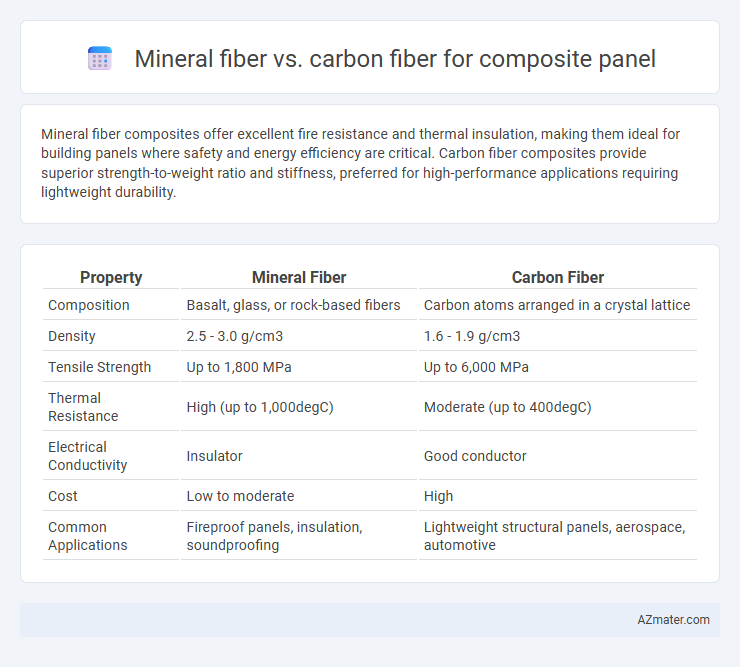Mineral fiber composites offer excellent fire resistance and thermal insulation, making them ideal for building panels where safety and energy efficiency are critical. Carbon fiber composites provide superior strength-to-weight ratio and stiffness, preferred for high-performance applications requiring lightweight durability.
Table of Comparison
| Property | Mineral Fiber | Carbon Fiber |
|---|---|---|
| Composition | Basalt, glass, or rock-based fibers | Carbon atoms arranged in a crystal lattice |
| Density | 2.5 - 3.0 g/cm3 | 1.6 - 1.9 g/cm3 |
| Tensile Strength | Up to 1,800 MPa | Up to 6,000 MPa |
| Thermal Resistance | High (up to 1,000degC) | Moderate (up to 400degC) |
| Electrical Conductivity | Insulator | Good conductor |
| Cost | Low to moderate | High |
| Common Applications | Fireproof panels, insulation, soundproofing | Lightweight structural panels, aerospace, automotive |
Overview of Composite Panels
Mineral fiber composite panels offer enhanced fire resistance and sound insulation, making them ideal for building facades and interior applications. Carbon fiber composite panels provide superior strength-to-weight ratios and stiffness, widely used in aerospace and automotive industries. Both materials contribute uniquely to composite panel performance, with mineral fiber excelling in thermal properties and carbon fiber dominating in mechanical strength.
Introduction to Mineral Fiber
Mineral fiber, often derived from natural or synthetic inorganic materials such as basalt, glass, or rock wool, offers excellent thermal insulation and fire-resistant properties, making it a key component in composite panel manufacturing. Its high melting point and sound absorption capabilities provide enhanced safety and energy efficiency in building applications. Compared to carbon fiber, mineral fiber is more cost-effective and environmentally friendly, though it generally has lower tensile strength and stiffness.
Introduction to Carbon Fiber
Carbon fiber is a high-strength, lightweight material widely used in composite panels due to its exceptional stiffness and tensile strength, outperforming traditional mineral fibers. Composed of thin strands of carbon atoms bonded in a crystalline structure, it provides superior mechanical properties and resistance to fatigue and corrosion. Carbon fiber composites are ideal for applications demanding high performance and durability, such as aerospace, automotive, and sports equipment industries.
Mechanical Properties Comparison
Mineral fiber composite panels exhibit high fire resistance and excellent thermal insulation but have lower tensile strength and stiffness compared to carbon fiber composites, which outperform with superior tensile strength up to 6000 MPa and modulus of elasticity reaching 300 GPa. Carbon fiber panels demonstrate significantly higher fatigue resistance and impact strength, making them ideal for applications requiring high mechanical performance and lightweight construction. Mineral fiber offers enhanced sound absorption and durability under thermal stress, while carbon fiber excels in load-bearing capacity and structural rigidity in composite panels.
Weight and Density Analysis
Mineral fiber composites typically exhibit higher density ranging from 2.5 to 3.0 g/cm3 compared to carbon fiber composites, which have densities around 1.6 g/cm3, making carbon fiber panels significantly lighter. The lower density of carbon fiber results in superior strength-to-weight ratios, enhancing performance in aerospace and automotive applications where weight reduction is critical. Mineral fiber, while denser, offers cost advantages and excellent fire resistance, but for lightweight structural panels, carbon fiber remains the preferred choice due to its exceptional weight and density benefits.
Thermal Resistance and Insulation
Mineral fiber offers superior thermal resistance and insulation properties in composite panels due to its inherent non-combustible structure and low thermal conductivity, making it ideal for fire-resistant applications. Carbon fiber composites provide exceptional mechanical strength but exhibit higher thermal conductivity, reducing their effectiveness as thermal insulators. For enhanced thermal insulation and fire safety, mineral fiber remains the preferred material in composite panel construction.
Durability and Longevity
Carbon fiber composite panels exhibit superior durability and longevity due to their high tensile strength, resistance to corrosion, and lower susceptibility to fatigue compared to mineral fiber composites. Mineral fiber panels, while offering good thermal insulation and fire resistance, tend to degrade faster under prolonged moisture exposure and mechanical stress. The enhanced lifespan of carbon fiber composites makes them ideal for applications demanding long-term structural integrity and minimal maintenance.
Cost and Economic Considerations
Mineral fiber composite panels typically offer lower material and production costs compared to carbon fiber, making them more economically viable for large-scale construction projects. Carbon fiber panels, while significantly more expensive due to raw material and manufacturing complexities, provide superior strength-to-weight ratios and durability that may justify higher upfront investments in aerospace or high-performance applications. Choosing between mineral and carbon fiber composites depends on balancing budget constraints with performance requirements and lifecycle cost efficiency.
Environmental Impact and Sustainability
Mineral fiber composites exhibit lower carbon footprints due to their abundant natural raw materials and energy-efficient production processes, contributing to enhanced environmental sustainability. Carbon fiber composites, while offering superior strength-to-weight ratios, involve high energy consumption and significant greenhouse gas emissions during manufacturing, impacting their overall ecological footprint. Recycling challenges of carbon fiber contrast with the easier recyclability and biodegradability of mineral fiber composites, reinforcing sustainability advantages for mineral-based panels.
Applications in Industry Sectors
Mineral fiber composites are widely used in construction and fire protection applications due to their excellent thermal insulation and fire-resistant properties. Carbon fiber composites dominate aerospace, automotive, and sports equipment industries, valued for their superior strength-to-weight ratio and high stiffness. While mineral fiber offers cost-effective solutions for thermal barriers, carbon fiber enables high-performance structural components demanding lightweight durability.

Infographic: Mineral fiber vs Carbon fiber for Composite panel
 azmater.com
azmater.com